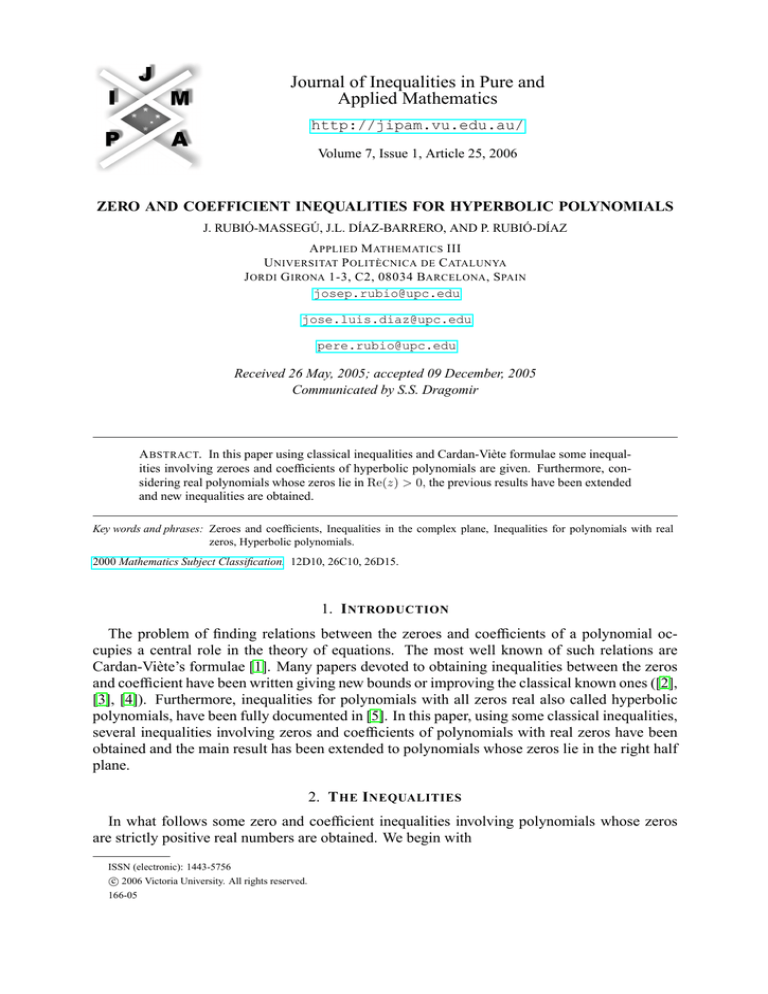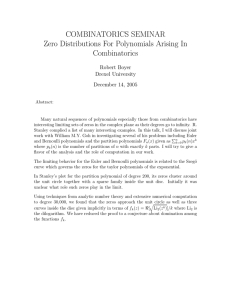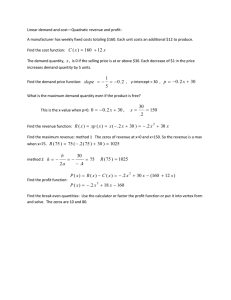
Journal of Inequalities in Pure and
Applied Mathematics
http://jipam.vu.edu.au/
Volume 7, Issue 1, Article 25, 2006
ZERO AND COEFFICIENT INEQUALITIES FOR HYPERBOLIC POLYNOMIALS
J. RUBIÓ-MASSEGÚ, J.L. DÍAZ-BARRERO, AND P. RUBIÓ-DÍAZ
A PPLIED M ATHEMATICS III
U NIVERSITAT P OLITÈCNICA DE C ATALUNYA
J ORDI G IRONA 1-3, C2, 08034 BARCELONA , S PAIN
josep.rubio@upc.edu
jose.luis.diaz@upc.edu
pere.rubio@upc.edu
Received 26 May, 2005; accepted 09 December, 2005
Communicated by S.S. Dragomir
A BSTRACT. In this paper using classical inequalities and Cardan-Viète formulae some inequalities involving zeroes and coefficients of hyperbolic polynomials are given. Furthermore, considering real polynomials whose zeros lie in Re(z) > 0, the previous results have been extended
and new inequalities are obtained.
Key words and phrases: Zeroes and coefficients, Inequalities in the complex plane, Inequalities for polynomials with real
zeros, Hyperbolic polynomials.
2000 Mathematics Subject Classification. 12D10, 26C10, 26D15.
1. I NTRODUCTION
The problem of finding relations between the zeroes and coefficients of a polynomial occupies a central role in the theory of equations. The most well known of such relations are
Cardan-Viète’s formulae [1]. Many papers devoted to obtaining inequalities between the zeros
and coefficient have been written giving new bounds or improving the classical known ones ([2],
[3], [4]). Furthermore, inequalities for polynomials with all zeros real also called hyperbolic
polynomials, have been fully documented in [5]. In this paper, using some classical inequalities,
several inequalities involving zeros and coefficients of polynomials with real zeros have been
obtained and the main result has been extended to polynomials whose zeros lie in the right half
plane.
2. T HE I NEQUALITIES
In what follows some zero and coefficient inequalities involving polynomials whose zeros
are strictly positive real numbers are obtained. We begin with
ISSN (electronic): 1443-5756
c 2006 Victoria University. All rights reserved.
166-05
2
J. RUBIÓ -M ASSEGÚ , J.L. D ÍAZ -BARRERO , AND P. RUBIÓ -D ÍAZ
P
Theorem 2.1. Let A(x) = nk=0 ak xk , an 6= 0, be a hyperbolic polynomial with all its zeroes
x1 , x2 , . . . , xn strictly positive. If α, p and b are strictly positive real numbers such that α < p,
then
1 1 −1 n
X
1
α p p − α α p a1 (2.1)
1 ≤
1
a0 .
p
b
α
α
[x
+
b]
p
k
k=1
p1 n
bα
.
Equality holds when A(x) = an x − p−α
bα
Proof. Let β and a be strictly positive real numbers defined by β = 1 − αp > 0 and a = pβ
> 0.
Taking into account that αp + β = 1 and applying the powered AM-GM inequality, we have for
all k, 1 ≤ k ≤ n,
α
α
(2.2)
(xpk ) p aβ ≤ xpk + βa.
p
Inverting the terms in (2.2) yields
1
1
≤ α β , 1 ≤ k ≤ n,
α p
x + βa
xk a
p k
or equivalently
xpk
1
α
1
≤ · α β.
p
+ α βa
p xk a
Taking into account that αp βa = b and β =
xpk
p−α
,
p
we have
α
1
1
1
≤ · β α
+b
p
xk
bα
pβ
β
α p ββ 1
= · β β α
p b α xk
α
α
1−
p−α 1−
α p p( p ) p 1
= ·
· α
α
α
p
xk
b1− p α1− p
α 1− αp
αp p − α
1
.
=
xαk
p
b
Raising to
1
α
both sides of the preceding inequality, yields
1 1 −1
αp p − α α p 1
1
,
1 ≤ k ≤ n.
1
1 ≤
b
xk
pα
[xpk + b] α
Finally, adding up the preceding inequalities, we obtain
1 1 1 −1
1 −1 n
n
X
αp p − α α p
1
αp p − α α p X 1
= 1
1
1 ≤
p
b
b
xk
α
pα
pα
k=1
k=1 [xk + b]
a1 a0 and (2.1) is proved.
Notice that equality holds in (2.1) if and only if equality holds in (2.2) for 1 ≤ k ≤ n.
p1
p1
1
bα
bα
= p−α
. That is,
Namely, equality holds when xpk = a, 1 ≤ k ≤ n or xk = a p = pβ
n
1
p
bα
, an 6= 0.
when A(x) = an x − p−α
J. Inequal. Pure and Appl. Math., 7(1) Art. 25, 2006
http://jipam.vu.edu.au/
Z ERO
When α > p changing α by
1
α
AND
C OEFFICIENT I NEQUALITIES
and p by
1
p
3
into (2.1), we have the following:
Corollary 2.2. If α, p and b are strictly positive real numbers such that α > p, then
α−p n
X
a1 1
pp α − p
.
≤ α
1
a0 α
b
p
k=1 [xk + b]α
Multiplying both sides of (2.2) by αp and raising to α1 , we obtain for 1 ≤ k ≤ n,
p α1 β
p α1
a α xk .
≥
xpk + βa
α
α
bα
Setting β = 1 − αp , a = pβ
into the preceding expression and, after adding up the resulting
inequalities, we get
Corollary 2.3. If α, p and b are strictly positive real numbers such that α < p, then
α1 − p1 1 n
X
an−1 α
1
p
b
p
(xk + b) α ≥ 1
an p
−
α
p
α
k=1
holds.
Another, immediate consequence of (2.1) is the following.
P
Corollary 2.4. Let A(x) = nk=0 ak xk , an 6= 0, be a hyperbolic polynomial with all its zeroes
x1 , x2 , . . . , xn strictly positive. Then,
n
X
1 a1 1
≤ 2 [xn + 2n − 1]2
4n a0
k=1
k
holds.
Proof. Setting α = 12 , p = n and b = 2n − 1 into (2.1), we have
1
2− n1
n
1 n X
n − 12
1
2
≤
n
2
n2
2n − 1
[x
+
2n
−
1]
k
k=1
1
1 1 n 2− n
a1 1
2
=
a0 n2
2
1 a1 = 2 .
4n a0
a1 a0 Note that equality holds when xk = 1, 1 ≤ k ≤ n. That is, when A(x) = an (x − 1)n . This
completes the proof.
P
Considering the reverse polynomial A∗ (x) = xn A(1/x) = nk=0 an−k xk , we have the following
Theorem 2.5. If α, p and b are strictly positive real numbers such that α < p, then
1
α1
n X
1 an−1 1
xpk
αp
−
.
(2.3)
≤ 1 1 · (p − α) α p p
a
x
+
b
p
n
α
p b
k
k=1
1 n
b(p−α) p
Equality holds when A(x) = an x −
, an 6= 0.
α
J. Inequal. Pure and Appl. Math., 7(1) Art. 25, 2006
http://jipam.vu.edu.au/
4
J. RUBIÓ -M ASSEGÚ , J.L. D ÍAZ -BARRERO , AND P. RUBIÓ -D ÍAZ
Proof. Since A∗ (x) has zeros
n
X
k=1
1
, . . . , x1n ,
x1
1
h p
1
xk
+b
then applying (2.1) to it, we get
1
1 −1 αp
p − α α p an−1 i α1 ≤ α1 ·
an .
b
p
Developing the LHS of the preceding inequality, we have
1
α1
1 −1
n xpk
p−α α p
αp
1 X
≤ 1 ·
1
p
1
b
b α k=1 b + xk
pα
and rearranging terms, yields
n X
α1
an−1 an ,
α1 − p1 an−1 ≤b · 1 ·
1
an α
p
b
k=1
1
1
α p p1
− p1 an−1 α
= 1 · b · (p − α)
.
an pα
Finally, replacing b by 1/b in the preceding inequality we get (2.3) asclaimed.
p1 n
α
Applying Theorem 2.1, equality in (2.3) holds when A∗ (x) = an x − b(p−α)
. Takxpk
+ xpk
1
1
α
αp
p−α
b
inginto account that
we have changed b by 1/b, equality will hold if and only if A(x) =
p1 n
an x − b(p−α)
, an 6= 0 and the proof is completed.
α
Next, we state and prove the following:
Theorem 2.6. Let A(x) be a hyperbolic polynomial with zeros x1 , x2 , . . . , xn such that x1 ≤
x2 ≤ · · · ≤ xn . Let α, p and b be strictly positive real numbers such that α < p. If a < x1 or
a > xn , then
1 1 −1 n
X
1
α p p − α α p P 0 (a) (2.4)
1 ≤
1
P (a) .
p
b
α
α
[|x
−
a|
+
b]
p
k
k=1
Equality holds when
"
A(x) = an x − a +
"
A(x) = an x − a −
bα
p−α
bα
p−α
p1 #!n
or
p1 #!n
.
Proof. First, we observe that (2.1) applied to polynomial P (−t) where P (t) has all its zeros
t1 , t2 , . . . , tn negative, yields
1
1 −1 n
X
αp
p − α α p a1 1
(2.5)
1 ≤
1 ·
a0 ,
p
b
α
pα
k=1 [|tk | + b]
p1 n
bα
where equality holds when P (t) = an t + p−α
, an 6= 0.
Now, we consider the hyperbolic polynomial of the statement and assume that (i) a < x1 or
(ii) a > xn . Let B(x) = A(x + a), the zeros of which are x1 − a, x2 − a, . . . , xn − a. Observe
that, they are positive for case (i), and negative for case (ii). On the other hand, coefficients a0
J. Inequal. Pure and Appl. Math., 7(1) Art. 25, 2006
http://jipam.vu.edu.au/
Z ERO
AND
C OEFFICIENT I NEQUALITIES
5
and a1 of B(x) are B(0) = A(a) and B 0 (0) = A0 (a) respectively. Applying (2.1) to B(x) in
case (i) or (2.5) in case (ii) we get (2.4).
p1 n
bα
Finally, we see that equality in (2.4) holds in the case (i) when B(x) = an x − p−α
,
p1 n
bα
. In case (ii) we will get equality when
or equivalently when A(x) = an x − a + p−α
p1 n
p1 n
bα
bα
B(x) = an x + p−α
, an 6= 0. That is, when A(x) = an x − a − p−α
and
the proof is completed.
Finally, in the sequel we will extend the result obtained in Theorem 2.1 to real polynomials
whose zeros lie in the half plane Re(z) > 0 and they have an imaginary part “sufficiently small”.
This is stated and proved in the following.
Pn
k
Theorem 2.7. Let A(z) =
k=0 ak z be a polynomial with real coefficients whose zeros
z1 , z2 , . . . , zn lie in Re(z) > 0 and suppose that | Im(z)| ≤ r Re(zk ), 1 ≤ k ≤ n for some
real r ≥ 0. Let α, p and b be strictly positive real numbers such that α < p, then
(2.6)
1
n
X
1
k=1
[|zk |p + b] α
1
≤
αp
1
pα
·
p−α
b
α1 − p1
bα
p−α
p1
·
√
a1 1 + r2 .
a0
For r > 0, equality holds when n is even and
A(z) =
2
z2 − √
·
1 + r2
z+
bα
p−α
p2 ! n2
.
Note that when r = 0 the preceding result reduces to (2.1).
Proof. Setting xk = |zk | and repeating the procedure followed in proving (2.1), we get
1
n
X
1
k=1
[|zk |p + b] α
1
≤
αp
1
pα
·
p−α
b
α1 − p1 X
n
1
.
|zk |
k=1
P
Next, we will find an upper bound for the sum S = nk=1 |z1k | . Reordering the zeros of A(z) in
the way z1 , z1 , z2 , z2 , . . . , zs , zs , x1 , . . . , xt ,where x1 , . . . , xt are the real zeros (if any), then the
preceding sum becomes
s
t
s
t
X
X
X
X
1
1
|zk |
1
+
=2
.
S=2
2 +
|zk | k=1 |xk |
|xk |
|zk |
k=1
k=1
k=1
On the other hand, by Cardan-Viète formulae, we have
X
t
s t
s
X
a1 X 1
1
1
Re zk X 1
− =
+
+
=2
+
.
a0
zk zk
xk
xk
|zk |2
k=1
k=1
k=1
k=1
J. Inequal. Pure and Appl. Math., 7(1) Art. 25, 2006
http://jipam.vu.edu.au/
6
J. RUBIÓ -M ASSEGÚ , J.L. D ÍAZ -BARRERO , AND P. RUBIÓ -D ÍAZ
p
√
Taking into account that |zk | = (Re zk )2 + (Im zk )2 ≤ 1 + r2 |Re zk | and the fact that the
zeros of A(z) lie in Re(z) > 0, yields
S=2
(2.7)
s
t
X
X
|zk |
1
+
2
|xk |
|zk |
k=1
k=1
s
t
X
√
|Re zk | X 1
2
≤2 1+r
+
|xk |
|zk |2
k=1
k=1
≤
√
1 + r2
2
s
X
|Re zk |
k=1
=
√
1+
r2
|zk |2
t
X
1
+
|xk |
k=1
!
a1 ,
a0 from which (2.6) immediately follows.
Next, we will see when equality holds in (2.6). If r > 0, to get equality in (2.6) we require
p1
bα
that (i) all the zeros of A(z) have modulus |zk | = p−α
, because when xk = |zk | the powered
GM-AM inequality (2.2) must become equality, (ii) |Im zk | = r Re zk , 1 ≤ k ≤ s, due to the
fact that the inequality in (2.7) must become equality, and (iii) all the zeros of A(z) must be
complex because the second inequality in (2.7) also must be an equality. Now it is easy to see
that the previous conditions are equivalent to say that n is even and
p1
bα
n
1
[1 + ri], 1 ≤ k ≤ .
zk = √
2
p−α
2
1+r
Multiplying the preceding zeros we get that inequality in (2.6) holds when n is even and
p1
p2 ! n2
bα
2
bα
A(z) = z 2 − √
z+
.
p−α
1 + r2 p − α
This completes the proof.
R EFERENCES
[1] F. VIÈTE, Opera Mathematica, Leiden, Germany, 1646.
[2] M. MARDEN, Geometry of Polynomials, American Mathematical Society, Providence, Rhode Island, 1989.
[3] Th.M. RASSIAS, Inequalities for polynomial zeros, 165–202, in Th.M. Rassias, (ed.), Topics in
Polynomials, Kluwer Academic Publisher, Dordrecht, 2000.
[4] Q.I. RAHMAN
2002.
AND
G. SCHMEISSER, Analytic Theory of Polynomials, Clarendon Press, Oxford
[5] D. MITRINOVIĆ, G. MILOVANOVIĆ AND Th.M. RASSIAS, Topics in Polynomials: Extremal
Problems, Inequalities and Zeros, World Scientific, Singapore, 1994.
J. Inequal. Pure and Appl. Math., 7(1) Art. 25, 2006
http://jipam.vu.edu.au/








